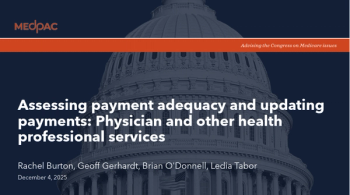
- December 25, 2018 edition
- Volume 95
- Issue 24
What's ruining medicine for physicians: Rising staff and overhead costs
Rising staff and overhead costs ranks 7th on the list of issues ruining medicine for physicians.
At the end of every year, Medical Economics publishes a list of the top challenges facing physicians. This list is generated by surveying our physician readers.
For this year’s list, we decided to recast the question. Instead of asking what challenges physicians face, our editorial staff wanted to hone in on what issues annoy and frustrate doctors and get in the way of what’s truly important: Treating patients and running practices.
And so we asked physicians in a poll: “What ruining medicine for physicians?”
In our list of the nine issues ruining medicine for physicians, the goal is not to dwell on the negative aspects of working as a physician. Instead, we wanted to show our readers that they share common challenges when dealing with the vexing issues facing primary care in today’s complex healthcare environment. Each piece also offers practical solutions that physicians can start using in their practices today.
#7 Rising staff and overhead costs
Every business grapples with rising employee and overhead costs, but these increases are particularly distressing for physician practices. Since 2013, the median operating costs for primary care practices rose by 13 percent, according to a 2018 Medical Group Management Association (MGMA) report.
“What I think has made it more acute and painful for physician practices is that earnings have remained fairly flat,” says Susanne Madden, president and CEO of The Verden Group, a practice-management consulting firm in Nyack, N.Y. “We’re not seeing insurance companies increasing payments to providers that keep pace with their burgeoning expenses.”
To combat these rising business costs, practices must balance reducing expenses with driving revenue growth. Here are four strategies that can help practices succeed in the face of financial constraints.
Find the best vendor contracts
Get the best prices for medical and office supplies, medications, vaccines, and other overhead services by taking advantage of discount contracts. These contracts are easy to find with a bit of research and can be secured independently or through group purchasing, but it’s important to stay abreast of what’s available, says Deborah Winiger, MD, a solo family physician in Vernon Hills, Ill. “I was discussing vaccines [with another physician] and he was paying $50 more a dose [than I was] for one shot, and he had no idea.”
Expand practice offerings
Ancillary services can improve the bottom line but often require considerable upfront investment. If a practice is not financially ready to add an ancillary service, Madden recommends renting out practice space to complementary specialties and/or offering educational sessions on pertinent topics, such as mental health or nutrition, that patients can attend for a modest fee. These offerings require minimal investment while providing value for patients and a revenue boost for the practice.
Invest in staff
Administrative and clinical staff members play a pivotal role in the success or failure of a practice, and employing non-physician providers leads to increased revenue despite greater expenses, according to the 2018 MGMA report. Therefore, it pays to hire and retain skilled and engaged employees, even if that means offering them competitive wages and benefits. “You want to make sure you can attract the good ones,” Madden says. “[If you don’t] it hurts you in so many ways-from patient frustration with a person who doesn’t know what they’re doing up front to the physicians not being adequately supported in their clinical work.”
Solicit patient feedback
Don’t rely on trial and error to pinpoint which areas of the practice are functioning well and which need improvement, as decisions based on incorrect assumptions can be expensive to rectify. “Ask your patients,” Madden says. “You have a focus group coming through your doors every day that you’re open.” She suggests utilizing check in to survey returning patients on potential practice changes, such as additional appointment times or new services. Similarly, check out provides the opportunity to inquire about and address any issues patients may have experienced during their visits.
Asking patients what they want from the practice is key to improving patient satisfaction, which increases the likelihood of retaining current patients and acquiring new ones without any additional marketing costs. “My practice has been built on loyalty of patients. A lot of my patients have been with me the whole time, and they refer their friends and coworkers,” Winiger says. “Be good to your patients and be a good physician. That brings patients in and helps the bottom line.”
Articles in this issue
almost 7 years ago
The human side of medicinealmost 7 years ago
Medicare fraud and abusealmost 7 years ago
What's ruining medicine for physicians: Difficulty using EHRsalmost 7 years ago
What's ruining medicine for physicians: Government regulationsabout 7 years ago
Reimbursement for obesity counselingabout 7 years ago
Dealing with EHR buyer's remorseabout 7 years ago
Physicians enter the gun violence debateabout 7 years ago
What's ruining medicine for physicians: Prior authorizationsabout 7 years ago
The costs and benefits of in-house lab testingNewsletter
Stay informed and empowered with Medical Economics enewsletter, delivering expert insights, financial strategies, practice management tips and technology trends — tailored for today’s physicians.
















